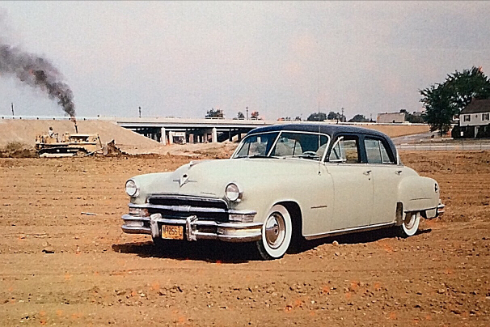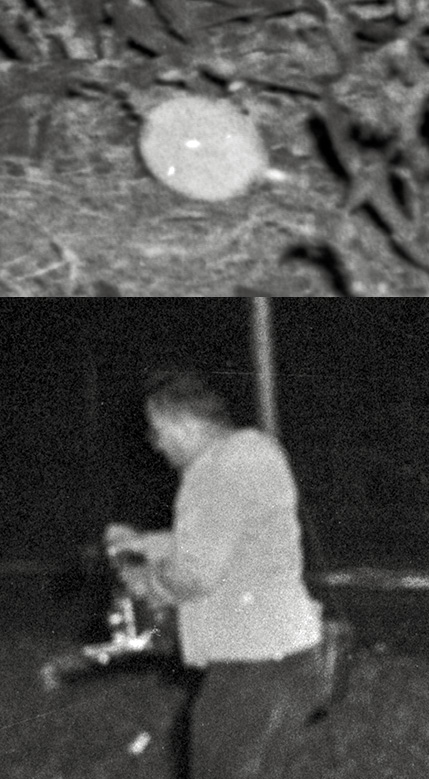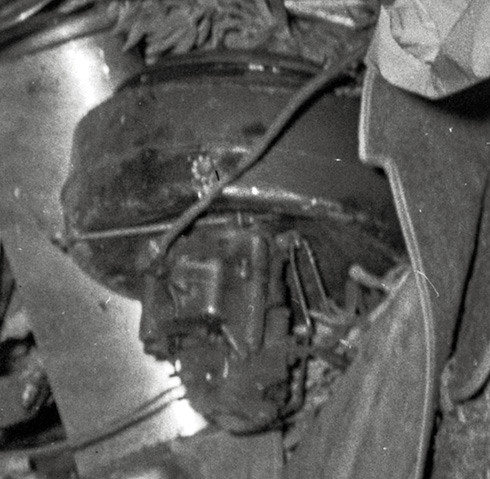


Framed or unframed, desk size to sofa size, printed by us in Arizona and Alabama since 2007. Explore now.
Shorpy is funded by you. Patreon contributors get an ad-free experience.
Learn more.

- Baldwin 62303
- Baldwin VO-1000
- Cold
- No expense spared
- Tough Guys
- Lost in Toyland
- And without gloves
- If I were a blindfolded time traveler
- Smoke Consumer Also Cooks
- Oh that stove!
- Possibly still there?
- What?!?
- $100 Reward
- Freeze Frame
- Texas Flyer wanted
- Just a Year Too Soon
- WWII -- Replacing men with women at the railroad crossing.
- Yes, Icing
- You kids drive me nuts!
- NOT An Easy Job
- I wonder
- Just add window boxes
- Icing Platform?
- Indiana Harbor Belt abides
- Freezing haze
- Corrections (for those who care)
- C&NW at Nelson
- Fallen Flags
- A dangerous job made worse
- Water Stop
Print Emporium
Arriving at Destination: 1957

Oakland, California, circa 1957, and a compacted Chrysler. We declare Pole S1274 the winner. 4x5 acetate negative from the News Archive. View full size.
Lost and Found
The radiator is not missing. Look above the floor mat. It is flat on the ground with a hose sticking up and the filler cap/neck mangled so it also sticks up.
Out of the Picture
Given the trail of debris and fluids, and the fact that the impact was clearly at the front left quarter, my guess is that the kinetic energy of the moving engine and transmission ripped them off the frame and they are sitting out the picture to the left. Note that the grille and radiator are also nowhere to be seen.
Big Engine
I owned (as a work car) a 1952 Imperial with a V8 Hemi engine. A straight eight was also available but no six was in the line-up. The vehicle was as smooth as silk and rode extremely well. The Hemi gave it extraordinary performance, of course. I too am puzzled as to why there is no evidence of the motor. As to the camera in the hands of the other photographer, it is the work-horse of that era, a 4"x5" Speed Graphic.

Crumple Zones
Todays modern vehicles have built in "crumple zones" Areas in front of the cowl to absorb collision damage. Even with severe damage to the front end, the damage rarely extends into the passenger compartment. This plus all the other safety items have cut fatalities almost in half since the 50's.
FLASH !
Are those flashbulbs in the grass by the driver's door? I think that's a photographer to the left of the pole.

Trolley Pole S1274?
Telescoped poles like that were usually for supporting streetcar or trolleybus wires. Back then they were driven into the ground like wood utility poles, so they don't break away like more modern street lights that have sacrificial bolts at ground level. Old concrete light posts and trees became targets for many moving vehicles.
The removal of such "fixed hazardous objects" from the sides of highways certainly made them safer, but unfortunately extending that practice to city and suburban streets encourages faster more dangerous driving, and it puts pedestrians, cyclists, and even children playing in their front lawns in more danger from wayward motorists.
That's no brake drum
It's a carburetor with the air cleaner still attached.
(edit: based on Internet pictures it appears to be a Carter one barrel Carb for a 49-54 model, therefore a six cylinder engine)
Other questions to be answered are:
How did the floor mat get on the outside of the vehicle?
What is that plastic sheet looking thing, possibly used to cover the driver until the Coroner (or more optimistically, Ambulance) arrived?
And how did they extract the driver from that mess.

Where'd the engine go?
At first, I thought it had been driven back into the passenger compartment, but those old Chrysler Firedomes were huge and you'd think some of this one would show. I note what looks a lot like a broken timing chain cover (and maybe a starter motor?) lying some distance in front of the car and wonder if the engine didn't just keep going when the body came to a sudden stop.
Brake Booster
The dark object at the base of the pole is the power brake booster and master cylinder, torn loose from the firewall by the imapct. The left front wheel is to the right of the pole, compacted backward into the firewall and almost covered by the crumpled left fender. Note also the right front fender and inner fender assembly over to the left by the men.
EDIT: I agree with another member that the black item is the air cleaner with the carburetor still attached.
Wrong part
John J, I think the part that you describe as "the brake and hub" is actually the oil bath air filter still attached to the carburetor. That must have been some impact!
Asleep at the wheel?
The nighttime shot and lack of skid marks in photo suggest the driver might have been asleep at the time. The Chrysler struck Pole S1274 just inboard of the left front fender. Scrape marks on the pole indicate the car then rotated counter-clockwise. This rotation separated the wheel and tire from the brake and hub assembly with the brake and hub coming to rest in front of the vehicle. The impact location also stiffened the steering column increasing the damage to the driver.
[Asleep, or very drunk. - Dave]
No thanks.
Dave, I probably could do without the photos where someone surely died. Maybe a blurred preview picture with a warning to click if you dare?
My university had four young athletes die in a one car crash into a tree just off the road. This picture gave me a big sad.
[There's nothing wrong with being sad. You'll get over it. As for trigger warnings on 60-year-old photos of empty cars, not gonna happen. - Dave]
Sorry not Safe
I own a 1956 Dodge Coronet, and when people join me for a ride they often comment (because of the vehicle's bulk and relative lack of plastics) that they feel safe compared to today's vehicles. As seen here, they are wrong -- today's vehicles are safer, period.
1952 Imperial?
Most of the early 50s Chryslers looked pretty similar but I didn't always see the Chrysler script on the hood on models other than 1952

Probably not a low speed crash
I'm not so sure this was low speed as someone previously commented. To fold a big heavy car up like that I'd say the driver was going at a pretty good clip.
On the plus side
The steering column kept the driver from going through the windshield.

























On Shorpy:
Today’s Top 5